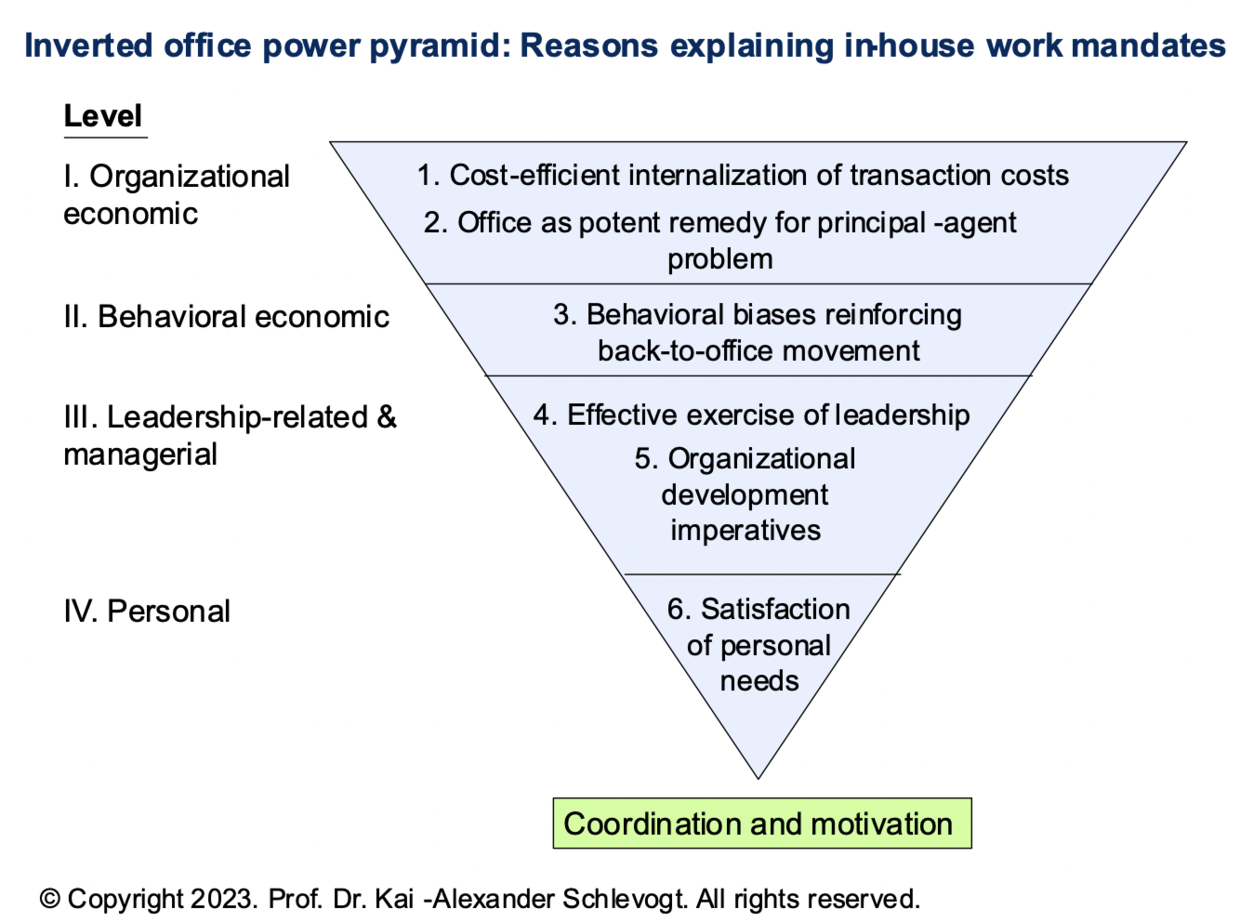
Why office work satisfies personal needs more than telework (Part four of Prof. Schlevogt’s four-part series on the future of work)

By Prof. Dr. Kai-Alexander Schlevogt, a globally recognized expert in strategic leadership and economic policy, who has served as Full University Professor at the Graduate School of Management (GSOM), St. Petersburg State University (Russia), where he held the University-Endowed Chair in Strategic Leadership. He also held professorships at the National University of Singapore (NUS) and Peking University.
By Prof. Dr. Kai-Alexander Schlevogt, a globally recognized expert in strategic leadership and economic policy, who has served as Full University Professor at the Graduate School of Management (GSOM), St. Petersburg State University (Russia), where he held the University-Endowed Chair in Strategic Leadership. He also held professorships at the National University of Singapore (NUS) and Peking University.
schlevogtwww.schlevogt.com

© Luis Alvarez/Getty Images
At Oxford University, undergraduates enjoy the privilege of weekly personal tutorials with a college don in grand, century-old buildings covered with ivy. If they happen to study Philosophy, Politics and Economics (PPE), they probably sooner or later need to write an essay about the following famous quotation by Greek polymath Aristotle: “Man is, by nature, a political animal.” If they are smart, they stress that a closer rendering of the ancient Greek text would be “polis-animal” or, even better, “a living being that belongs to the polis (or needs it),” as opposed to one that lives in solitude and is self-sufficient (autarkês).
Strictly speaking, the specific human institution of the classical polis refers exclusively to the distinctive Greek city-state (such as Athens in the fifth century BC) that is administered by its citizenry as opposed to a tyrant or an oligarchy (a small group of rulers). Aristotle, Plato’s poster-child student, who gave birth to the Peripatetic movement, reasoned teleologically that the polis exists by nature and that it is self-sufficient and the necessary condition for human existence. According to the Stagerit, the polis alone can satisfy all of man’s material and intellectual needs (Knoll, 2017). By nature (physei), man, who is gifted by reason and speech (logos), due to an inner impulse (hormê) is propelled towards this well-ordered, perfect community. The polis alone enables the perfect development of man (especially his logos), the full realization (energeia) of his function (ergon), natural human potentiality (dynamis) and final end (telos), as well as a perfect life and happiness (eudaimonia). Given man’s lack of self-sufficiency (autarkeia) and his communal inclinations, these outcomes supposedly cannot be achieved if he lives alone and thus does not cooperate for the common good (koinê sympheron) in a process of division of labor.
Applying Aristotle’s political anthropology, naturalism and psychology to today’s workplace, modern man can be conceptualized as an “office animal” by nature.
Drawing a comparison to the polis, one can conclude that the office – in contrast to social isolation at home, a state (stasis) that can be compared to scattered, solitary and asocial men without a polis (apolis) – best satisfies modern-day employees’ personal needs (which are based on human values) and acts as a powerful catalyst for them to flourish and live the good and happy life. This partly explains recent widespread office mandates after the surge in work from home (WFH) during the Covid-19 pandemic.
In my “Inverted office power pyramid” (see Figure 1), I have outlined the fundamental forces driving this seemingly unstoppable megatrend (see Prof. Schlevogt’s Compass № 3).
Figure 1

© Prof. Dr. Kai-Alexander Schlevogt. All rights reserved.
Apart from factors at the (I) organizational economic and (II) behavioral economic level (see Prof. Schlevogt’s Compass № 4), as well as on the (III) leadership-related and managerial plane (see Prof. Schlevogt’s Compass № 5), there are also important reasons for the back-to-office trend at the (IV) personal level. If, as according to my analogy, the office like the Greek polis satisfies human personal needs better than work in solitude, and an internal instinct drives man towards it, we need to ask: Which specific personal needs are most prominent in this regard, driving the seemingly unstoppable return-to-office megatrend at a microlevel?

Read more
6. Satisfaction of personal needs
Let us first analyze the generic personal needs of followers and afterwards examine the special needs of leaders, both of which are driving widespread calls for office attendance.
A. Common personal needs of followers
Robert Goffee, an emeritus professor at the London Business School (LBS), chose an intriguing question as the title of one of his books: “Why should anyone be led by you?” (Goffee & Jones, 2006). He answered this question by positing that followers want four things: (1) Authenticity, (2) significance, (3) excitement, and (4) community.
Desire for authentic inspiration
As a rule, the office satisfies the need for authenticity, significance, and excitement – aspects that partly are interrelated – better than WFH.
With respect to authenticity, followers want a leader who skillfully reveals his real distinctive self instead of a role player with a mask. A leader who only appears virtually by definition cannot be authentic in the full sense of the word. The problem becomes worse if the helmsman uses an avatar (an image that represents a user) to disguise his face during a video call.
In addition, as regards significance, followers want to feel that they matter instead of just being a factor of production called a “human resource.” Thus, recognizing employees is of vital importance. Given that recognition is most effective when it is targeted, specific, personalized and direct, addressing different senses (sight, hearing, etc.) and appealing to both reason and emotions, it is better to lavishly praise staff in person in a tailor-made fashion (possibly even in front of others) than remotely in a reductionist and unfeeling way. It should be noted that, among other things, skillful leaders try to make eye contact with all participants of a meeting to signal to them that they are important. In virtual meetings, such real eye contact is impossible. Part of making someone feel significant is portraying what he does as being significant and meaningful, a cause bigger than the individual. Again, such framing is easier when you work together physically than virtually – just think of the sense of mission and pride of a successful sports team that fights together and unleashes collective magic! Furthermore, the potential for intrinsic motivation and chance of obtaining psycho-social rewards in a process of social exchange, which transcends mere economic bargaining, tend to be higher in personal relationships, which are built in an enduring office setting rather than through an occasional computer-mediated transaction in the course of telework.
As regards excitement, the German sociologist Max Weber in 1904 already wrote about the “iron cage” of capitalism and bureaucracy. He noted the triumph of technical rationality and observed an apparent disenchantment (in German: Entzauberung) of the world. Obviously, with all the new means of electronic controls used in the course of remote work, there is now a new “digital iron cage” that is even narrower than the bureaucratic one, with excitement decreasing commensurately. For example, it is difficult to let loose and get thrilled if everything you ever say is recorded and can be used against you at some point in the future.
One means leaders use to create excitement is to vary social distance (Goffee & Jones, 2006), which involves at time being close to the followers and on other occasions being mysteriously and exhilaratingly remote. Obviously, telework makes it impossible to really get socially close to one’s subordinate. This removes one essential lever for creating excitement. Moreover, it is extremely difficult for helmsmen to electrify others with their own energy remotely. Furthermore, the office at times affords an exciting escape from home – a pattern that is comparable to the effect of a business trip (the need-driven resurgence of which will also lead to more face-to-face meetings). In addition, being exposed to conflict undermines positive feelings of excitement. Yet many conflicts tend to arise in online settings, partly because important communicative cues are missing and problems usually are not discussed early on in an informal matter, when they are still small and can be solved comparatively easily. In contrast, conflicts can be easily resolved in real time in an office setting.
Finally, a sense of excitement is generated by undertaking challenging learning journeys and achieving personal growth and career advancement as a result. Yet learning opportunities are severely curtailed in teleworking settings (see Prof. Schlevogt’s Compass № 5), where the richness of transformative leadership cannot be fully applied. Not surprisingly, IBM’s CEO Arvind Krishna concluded that remote work may hurt career development. The problem of being underled in telework settings is particularly acute for young employees, who have a particularly high need for professional guidance, disciplining and help from their superior and various formal and informal networks to improve their skills.
Furthermore, career advancement depends on being visible, which is easier in the office than remotely. It also hinges on the avoidance of derailment. In this context, it might be argued that the position of employees is somewhat more secure if they work in an office, where an executive might have to face them and their colleagues directly when he wants to fire them. In contrast, at least in human terms, it is much easier to dismiss someone who is only engaging in telework – you literally just need to switch off a computer button – and, if necessary, to replace him with freelancers and artificial intelligence tools.
Longing for community
The powerful return-to-office movement can also be viewed as an attempt to counter a broader societal megatrend: Widespread disintegration, disconnection, fragmentation, polarization, and loneliness in the United States (which often is a harbinger of pivotal social changes) and elsewhere. This fundamental change was broadly recognized after Robert D. Putnam’s seminal article “Bowling alone,” published in 1995 (Putnam, 1995) and his subsequent eponymous book (Putnam, 2000). In 2023, Vivek Murthy, the US surgeon general, spoke of an “epidemic of loneliness and isolation” (Murthy, 2023). According to the view of the nation’s doctor-in-chief, this social disease will reduce life expectancy in the same way as a daily intake of 15 cigarettes (Edgecliffe-Johnson, 2023). This trend is not limited to the United States, though.
In 2020, 8% of Britain’s adult population (that is, 4.2 million citizens) professed that they were “always or often lonely,” according to the country’s Office for National Statistics. Interestingly, new entries to this group of people who suffer from “acute loneliness” included those who worked from home during the pandemic. Besides, class differences between knowledge workers and other workers tend to increase in remote-work settings, since there is less opportunity for interaction between these two groups.

Read more
The problems of isolation, disintegration, and fragmentation are aggravated due to the rise of the gig-type economic sector with widespread “micro-jobbing” by polyworkers and job nomads. This is because, in this realm, atomized individuals are offering oftentimes rather low-value-added services to patrons through anonymous platforms on a transactional basis without social bonds. The problems are experienced by both white-collar and blue-collar workers who are performing gigs.
Not surprisingly, disconnection leads to negative economic outcomes in general. According to the US surgeon general, social disconnection increases absenteeism, which is estimated to create an annual cost of $154 billion for corporate America (Edgecliffe-Johnson, 2023).
Clearly, remote work also increases the feeling of exclusion (Stern, 2022), especially if there is a rival in-group of office workers. This is quite ironic given that many managers nowadays stress the importance of equitable “inclusion.” The problem of exclusion can surface in meetings that involve both office and remote workers, for example, where the teleworkers might not understand what is going on in the room (including subtle jokes). The wider application of artificial intelligence, among other things, will probably make things worse, given technology’s potential negative side effects. For example, tools like chatbots will accelerate the process of dehumanization and anonymization.
In contrast, the office is a powerful weapon for combatting what Starbuck’s CEO Laxman Narasimhan calls the “crisis of disconnection” (Edgecliffe-Johnson, 2023) and addresses the need for belonging mentioned above. The office is a place of unification in a polarized and lonely world. In this setting, people can enjoy the camaraderie of fellow workers, and different classes get together and thus reduce social cleavages. In addition, the office provides people with a great opportunity for human interaction that counteracts feelings of exclusion. There, humans can easily engage in face-to-face conversations, since there are other known people whom they can approach without the need to overcome the manifold psychological and social hurdles that exist elsewhere. This phenomenon is comparable to the comfortable presence of “anchor persons” in a party to whom you can talk first. Approachability in the office setting matters given the following results of a survey conducted by the British coffeehouse chain Costa Coffee in the UK: 75% of respondents desired to talk more to others, but 63% stated that they did not engage in conversations with unknown people because they were concerned about possibly being rebuffed.
It is also easier to make new connections in an office setting than in the disconnected outside world. For example, at least a third of new relationships are forged in the physical workplace (Bordwin, 1994). The office is a great social catalyst in this regard because it provides a common platform and is populated by people with shared interests. It affords geographic proximity, interconnection of tasks, and occasional contact opportunities with repeated exposure, all of which are pivotal factors that induce interaction (cf. Carson & Barling, 2008) and help to build social ties.
As regards economic outcomes, the office is a real profit-maker. For example, the US surgeon general found that supportive work ties are positively correlated with satisfaction on the job and drive innovativeness (Edgecliffe-Johnson, 2023). As a result, in a positive office environment, absenteeism will be lower and both individual and organizational performance will be higher compared to remote work. Given that loneliness is classified as a social disease, the office exerts a healing effect both with respect to mental and physical illnesses, thus reducing a nation’s medical bill.
Finally, a sense of community and affiliation with one’s organization is also important, since it provides employees with an idiosyncratic identity embedded in their jobs. It counteracts the pernicious tendencies described in the classic book “The lonely crowd” (Riesman, Denney, & Glazer, 1950), that is, the fact that increasing atomization of other-directed individuals without a strong inner gyroscope inhibits true self-development. Given such negative development patterns, it is a key task of leaders to encourage the formation of social ties inside the organization – a physical social network – and thus to develop a closely-nit community, as well as increase identification with one’s employer and a sense of self-worth.
Apart from the longing for authentic inspiration and community, work in the office also satisfies other personal needs of followers, which explains the back-to-office trend.
Desire for work-life balance and privacy
With the rise of work from home, the boundaries between the professional and personal spheres have been blurred in a new work continuum, and work has oftentimes become a quasi-permanent state. The expectations of employers have increased accordingly. Many superiors now disrespect conventional social boundaries and regard it as natural that their subordinates respond to calls and emails after work. Among other things, this tendency has led to overwork from the home base. Again, the problems become aggravated with the rise of the gig economy where microjobbers and polyworkers frequently get bombarded with requests from multiple employers without respect for work-home-boundaries. Employment laws in many countries have not caught up with the new realities, leaving employees unprotected and thus exploitable.

Read more
To be able to balance personal and professional needs, many employees desire a return to a clear division between work and home. The office – coupled with a right-to-disconnect policy, can satisfy this need since it socially and physically designates a separate space for work. When employees leave the office, they enter a tangibly and qualitatively different sphere. When the slogan “My home is my castle” applies again and there is a bulwark that protects against intruders who request the completion of tasks in the domicile, people can pursue social activities and build new bonds that instill personal meaning.
What is more, with the blurring of the professional and non-professional spheres, privacy has diminished. For example, private spaces (such as living rooms) and family members (such as babies crawling nearby) may be visible during video conferences. Even though neutral virtual backgrounds can be used or cameras switched off, many employees refrain from doing so because their superior may request to see them and dislikes artificial wallpapers, and because they do not want to be seen as hiding something. Besides, if all work is performed remotely, a host of electronic monitoring and surveillance tools (such as spyware) can be used, which further infringes on privacy. In contrast, working in the office enables employees to leave their private space at home protected.
B. Special needs of leaders
Apart from those personal factors that are common to followers, there are some leadership-specific needs that drive back-to-office mandates. Those needs in some cases fall into the realm of the dark side of leadership, overriding narrow productivity considerations.
Let us start with power, which can be broadly defined as the capacity to push through one’s will even against the will of others, on grounds that can be considered to be either legitimate or illegitimate. There is much evidence that leaders often have strong power needs. The office tends to be a better place than virtual environments to satisfy a leader’s power interests, at least through the exercise of authority, which is “accepted power,” since it is perceived as being legitimate. The German sociologist Max Weber listed three ideal types of such recognized authority: traditional, charismatic, and legal-rational (also termed bureaucratic power). Both at the personal and organizational level, at least the first two types of authorities work better when there is personal contact. As regards traditional authority, in the office, a leader is able to use tangible symbols and rituals that can be viscerally experienced, reinforcing values that inform and direct behavior. With respect to authority based on charisma (that is, the enchanting gift of a unique personal quality that sets a leader apart), it is easier to sway followers with one’s inspiring personality and palpable energy in face-to-face interactions than remotely. To the extent that bureaucratic procedures require the personal presence of employees – such as when they need to receive documents in person – the office is a better means for power-hungry leaders wanting to dominate others through legal-rational means, too. The office might also be a more powerful bureaucratic disciplinary device, making it easier to monitor and control a wider variety of behavioral facets than would be possible in remote settings.
Oftentimes, a leader’s hunger for power is related to narcissism, that is, self-centeredness coupled with the need for attention by others. More specifically, many rulers feel an almost irresistible urge to exhibit their power vis-à-vis others in a tangible way – after all, a hammer needs a real nail, not just a virtual one. Undoubtedly, it is much more pleasurable and easier to be seen and be applauded by a large crowd in an office setting than remotely. For example, in a physical workspace, the leader may engage in empire-building, amassing status symbols (such as spectacular offices) that impress others. It is useful to remember that the Oval Office in Washington was designed with the specific intent to impress guests, especially foreign dignitaries.
In addition, return-to-work mandates are driven by leaders who strive for high levels of productivity and are suspicious of claims made by their employees who allege that they are highly productive, which is sometimes labelled “productivity paranoia.” Indeed, studies found that superiors tend to have different perceptions than followers. For example, according to a recent survey regarding views on the impact of teleworking, a mere 12% of respondents at the chief executive level believed that employees are highly productive in the home office. In contrast, 87% of their employees professed to this rather positive perception of their remote work (Bailey, 2023).

Read more
Finally, leaders might also have sinister motives for issuing back-to-office mandates. Those policies might prompt some employees who are still keen to work from home to leave the company. Thus, managers may be able to reduce staff levels in a quiet manner.
Conclusion: Effectively coordinating and motivating human actors and raising productivity through office work
Admittedly, there are also aspects that may lead to a preference for remote work, which is still popular among specific staff segments. For example, for personal reasons, introverts (who source their energy from within) may favor work from home, whereas extroverts (who get their energy from the outside) may want to interact with others in a physical workspace. Yet, on balance and on average, viewed from the organizational economic and behavioral level (see my Compass column № 4), leadership-related and managerial plane (column № 5), as well as the personal level, work in the office in general tends to be a better way for coordinating the work of employees and motivating them than telework. This is due to fundamental structural and psycho-social factors, not just cyclical drivers (such as a recession lowering the bargaining power of employees and concomitantly increasing the power of employers to enforce strict office mandates). These factors are partially intertwined and tend to interact in a dynamic fashion. Here is an example of organizational dynamics, which involves feedback loops: In a hybrid, office-remote setting, participants in a virtual meeting might postpone pivotal decisions to times when they meet in person in the office, since they may regard virtual meeting places as inferior when it comes to making important calls. Over time, the slowing down of decision-making might depreciate the perceived value of remote settings and push leaders to issue sweeping office mandates, which in turn will further decrease the number of virtual meetings. Furthermore, employees might observe that office workers have a higher probability of being promoted, since, among other things, they are more visible. This might prompt remote workers to flock back to the office. Eventually, an inflection point in the fight for the return to the office will be reached, with a critical mass of employees returning to the physical workspace.
Whereas most reports on the comparative virtues of remote work are descriptive, I have unearthed office-inducing factors analytically and logically grounded them in theory. Besides, given that different work modes could be monitored and evaluated during the pandemic, there is much empirical evidence for the comparative effectiveness of the office. For example, Amazon’s CEO Andy Jassy made the following remark in a memo to his employees: “Because the pandemic lasted as long as it did, we were able to observe various models”. Based on this data, he concluded that the office has strong advantages over remote work in many regards. Importantly, this pattern does not only apply to the US, but to other countries, too.
The work of specialized individuals needs to be coordinated so that the results of the division of labor for the collective will be positive. Put in a nutshell, the task of coordination, among other things, is aided by better information flows in an office setting, where leaders can gain a richer picture of their employee’s behavior and motives than in remote settings, and by their ability to intervene directly and quickly. Furthermore, motivating employees is easier in an office setting, where a leader can fully address their psycho-social needs for authentic inspiration, community and work-life balance coupled with respect for privacy.
Despite the general comparative advantage of the office in many situations, the specific productivity impact depends on the type of measurement, industry and tasks (Wigglesworth, 2023), with the measured impact of home office work on productivity ranging from -19% to +13% (Hatzius, 2023). Undoubtedly, advances in remote work technologies and the new digital competencies of organizational members can sometimes be useful, since in certain cases, office work can be supplemented to varying degrees or at times even be entirely substituted by remote work in a beneficial manner. An example would be partially or fully resorting to remote work during a shutdown due to a severe health crisis or natural disaster. Furthermore, advances in remote technologies and skills tend to expand certain production-possibility frontiers and thus can open up new opportunities. For example, it might be possible to invite an expert, who cannot join in person due to time and cost constraints, to give a speech and join a discussion online.

Read more
It is important to note that new leadership skills will be required to manage occasional hybrid or fully remote settings as they arise. This entails developing granular criteria for evaluating the comparative effectiveness of office work in comparison to remote work in specific circumstances. Ideally, such an analysis should be performed in a holistic manner, taking into account externalities (that is, social costs, which, by definition, are not borne by those who caused them). For example, when an increasing number of employees work from home, inner city centers might become deserted and crime rates in such localities increase. Based on the differential assessment of office work compared to telework, leaders need to map and develop the skills required for each scenario, adopting a tailored and individualized approach to managing their people.
Finally, my analysis shows conclusively that the “Great Reset” vision (see my Compass column № 3), which has been proposed, for example, by the leadership of the World Economic Forum (WEF), at least in the short-term, will not materialize in full. The vision included a radical redesign of jobs in the wake of a technology-driven merging of physical, digital, and biological domains, which logically entailed an inflective trend towards more remote work. With the benefit of hindsight, the sweeping move to teleworking so far has been an aberration due to the pandemic. It was driven in part by normative, coercive and mimetic institutional isomorphism (that is, the tendency of organizations to become more alike to each, for example, due to the bias to follow the crowd). With centrifugal tendencies giving way to centripetal forces, office work rates are now in many places approaching previous pre-pandemic levels. Thus, in contrast to much publicized cross-sectional snapshots, my dynamic longitudinal analysis reveals the following pattern, which is in line with the widespread “regression toward the mean” tendency: Behind the glitter and hype of telework on the surface, the deeper-seated fundamentals that favor office work, due to the presence of systemic and anthropological constants, tend to stay more or less the same. In short, plus ça change, plus c’est la même chose!
This is the final part of Prof. Schlevogt’s four-part series on the future of work. Previous columns about this topic:
- Prof. Schlevogt’s Compass № 3: Great Reset visionaries stumble upon an unexpected roadblock (13 September 2023)
- Prof. Schlevogt’s Compass № 4: Why in-house work is not going extinct anytime soon – a look at the ‘inverted office power pyramid’ (20 September 2023)
- Prof. Schlevogt’s Compass № 5: How telework impedes leaders and their organizations (30 September 2023)
Note to readers: Please feel free to submit your questions related to a wide variety of political-economic issues in the comment section of this column. Prof. Schlevogt will subsequently endeavor to address these issues in his future columns.




